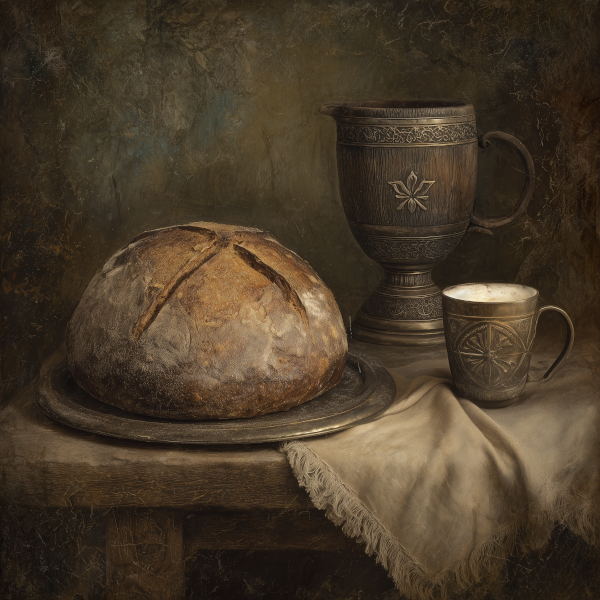Barmkin Loaf (BARM-kin)
“Ash for bite, brine for bloom—Nothing ever goes to waste in the northernmost region of Gression, not even the leftover froth, or barm, from fermenting ale. Most likely, some thrifty soul thought to add the leftover brewing mash to their bread dough, to stretch it a little further. The mash would have given the loaf body, it is sure, but without enough leavening, the loaf was heavy and dense. Then the idea of adding young ale or beer to the mix, to give it a lift from the brewer's yeast. This caused the loaves to rise somewhat, but success was hit or miss. Eventually, a correlation was seen between the amount of foam on the beer, and the amount of rise that resulted in the loaf. Over time, the idea of using the foam as an assist to the rising agent was refined, and the practice spread. The resulting loaf was thick and hearty, with a unique taste that was sour and sweet at once, with a delightful tangy note. Barmkin loaves quickly became a staple in Gression settlements, a fine way to reuse the brewer's mash and stretch the pantry. As wagons and logging roads were improved, villages were founded farther and farther north. These northerly settlements were small, and did not have easy access to traders or imported goods. There was not enough brewing demand to supply enough barm and mash for daily bread. Other means had to be found to keep the barmkin loaves rising enough to be edible. Experiments with keeping a Sourdough Starter to use, instead, paid off, and the barmkin found a new form. Folks would still add a touch of barm or a splash of ale, if they had it, to add to the flavor, but it was no longer a necessity. Today, both varieties of the barmkin loaf are staples through out Gression. No evening meal is complete without it, and many of the other meals, as well. Sourdough starters are often communal affairs, all starting from one crock, usually kept in a tavern or alehearth. Though each family tends their own, there is security in knowing that more can be traded for or borrowed in the event the worst should befall it. Traditionally, the barmkin is a round loaf, with a deep cross or other pattern scored into the top to help the steam escape cleanly. It is baked either in a clay or stone oven, if one is available in the village, or left to bake in a covered container of iron or clay near the hearth fire. A good Gression cook can tell if a loaf is done from the sound it makes. A good, hearty thump, like knocking on a log, indicates a bread that is cooked well through, but not overdone. Nor does the versatile loaf stop there. There are as many variations and versions as there are cooks in Gression. A harvest feast might call for a loaf with molasses or barley syrup stirred in, and cracked grain on top. In early spring, wild chives and garlic cloves are added for a fresh taste of green. When heavy work days come around, the barmkin is heartened with bits of meat and cheese, and for special occasions, dried fruit or stoneberries are mixed in for a sweeter treat. Beyond this, barmkin is more than just bread. It is there when people are born, when they marry, and when they are gone. An agreement between two parties is often finalized with the breaking and eating of barmkin bread. It welcomes the guest as well as the stranger, and welcomes home those who have journeyed and returned. It is more than just the taste of Gression, in a very real sense it is Gression.
Barmkin keeps the dark from room.”
“When the mash is warm and the barm is high, no one goes hungry.”
Item type
Consumable, Food / Drink
Weight
Heavier than a winter squash
Lighter than a dry log
Lighter than a dry log
Dimensions
Round as the stewpot lid
High as a fist laid on its side
High as a fist laid on its side
Typical Recipe
Ingredients
- 3 fists coarsely milled rye flour
- 1 fist white flour or sifted brewing mash
(if there’s any) - 1 ladle sour starter
- 1 small dipper of stonebrine vinegar
- 1 small pinch of fire salt
(or coarse salt and dried sage) - 1 to 1¼ tankards warm spring water
Preparation
- Mix flour and salt in large bowl
- Stir in water and starter
- Dough should be rough but sticky—if dry, add a splash more
- Cover it, leave warm overnight by the fire
- Shape into a round in the morning
- Let sit again while you get the oven hot
- Score deeply with a cross or other pattern
- Bake for about one hour in a hot oven
or in a covered clay or iron pot near the hearth - Knock it. If it gives a heavy thud, it’s done.
- Let it breathe before cutting.



Comments